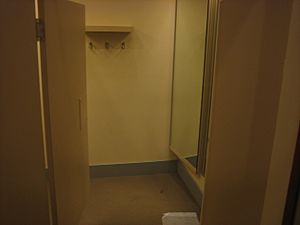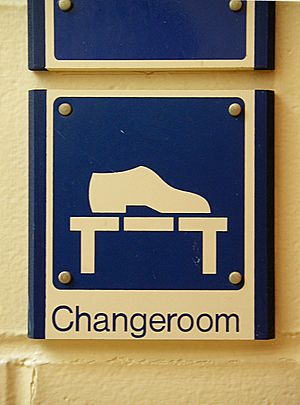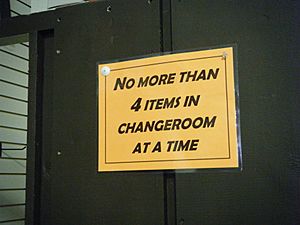Changing room facts for kids
A changing room is a special place where you can change your clothes. It's also called a locker room or dressing room, especially in places like sports centers or theaters. These rooms give you privacy, whether you're changing by yourself or in a room with others of the same gender.
Sometimes, there are separate changing rooms for boys and girls. Other times, there's a big open space with small, private cubicles or stalls inside. You might even change clothes in a toilet cubicle in a public washroom. Many changing rooms also have washrooms and showers. For example, at Yonge–Dundas Square in Toronto, the washrooms have a small area where people can change into bathing suits if they want to use the water play area.
Larger changing rooms are often found at public beaches or swimming spots. These usually have lots of space for changing and just a small washroom area. Beach changing rooms are often big open rooms with benches along the walls. Some don't even have a roof, just walls to keep people from seeing in.
Contents
Different Kinds of Changing Rooms
There are several types of changing rooms, each used for different reasons.
- Changing stalls are small, private areas where you can change clothes. They are often used at swimming pools.
- Locker rooms are usually for one gender (like boys or girls). You change clothes here and store your things in lockers. They are common for sports.
- Fitting rooms (or dressing rooms) are small, private rooms in stores where you try on clothes before you buy them.
- Green rooms and trap rooms are backstage areas in theaters where performers get ready and change outfits.
Private Changing Stalls
Changing stalls are small, private spaces where you can change your clothes. You usually store your clothes and bags in lockers nearby. Often, these stalls are not separated by gender. They might be next to shared showers that are separated for boys and girls. Many public swimming pools have these private stalls along with bigger, shared changing rooms.
Locker Rooms for Groups
Locker rooms get their name because they have lockers where you can store your belongings safely. Sometimes, there's even a person who looks after your things until you come back for them. Locker rooms are usually big open spaces where many people change at the same time. However, there are always separate locker rooms or separate areas for boys and girls. They are often used at swimming pools or sports centers.
To keep your things safe, lockers often use locks that need a key, a coin, or a combination lock. Some newer locker rooms are very modern! They might have robots to store clothes or use a fingerprint scanner to open your locker. At some waterparks, you might get a special wristband with a microchip. This wristband can unlock your locker and even let you buy food or drinks!
Some locker rooms are meant only for groups, not for single people. In these cases, there might not be individual lockers. Instead, the whole room is locked to keep everyone's belongings safe from theft. Locker rooms are also common in many middle schools and high schools, especially for physical education classes. Most of them include showers for after sports.
Store Fitting Rooms

Fitting rooms, also called "dressing rooms," are places in stores where you try on clothes. They are usually small, private rooms where you can see if clothes fit well before you decide to buy them. People don't always fully change in fitting rooms. Sometimes, they just try on a sweater or coat over their regular clothes, but they still want privacy to do it. So, fitting rooms are used for both changing and just trying on clothes.
Rules for Fitting Rooms
Stores often have rules posted for fitting rooms. For example, they might say "no more than 4 items allowed in changing room." This helps keep the rooms tidy and available for everyone.
History of Fitting Rooms
It seems that the first store fitting rooms appeared when department stores became popular. A French writer named Émile Zola wrote about them in his book Au Bonheur des Dames in 1883. He mentioned that back then, men were not allowed in them. But a few years later, that rule changed.
Fitting rooms have also been part of funny scenes in movies! For example, Buster Keaton worked in one in a 1928 American silent comedy called The Cameraman. They've continued to be used for laughs in films, like in the 1995 French movie Les Trois Frères.
Green Rooms for Performers
A green room is a room backstage in a theater or other performance space. It's where actors, musicians, or dancers wait before they go on stage. They are traditionally called "green rooms" because their walls were often painted green. Green is thought to have a calming effect, which helps performers relax and focus before their show. Even though they're called green rooms, they aren't always green!
Green rooms are usually backstage, but sometimes they are under the stage or to the side. When they are under the stage, they are often called "trap rooms." This is because many stage setups, especially for magicians, have a trap door that leads to a room below the stage. A performer might drop through a trap door onto a soft mat to "disappear" and quickly change into another outfit.
Green rooms are usually not separated by gender. This is because performers often work closely, like a family, and help each other change. For example, a husband and wife circus team might need to help each other put on special wires or safety harnesses. While some green rooms might have small, separate spaces (to follow building rules), the changing often happens in the main backstage area. Here, dressers and stagehands are ready to help with quick costume changes.
Images for kids
See also
 In Spanish: Vestuario (habitación) para niños
In Spanish: Vestuario (habitación) para niños










